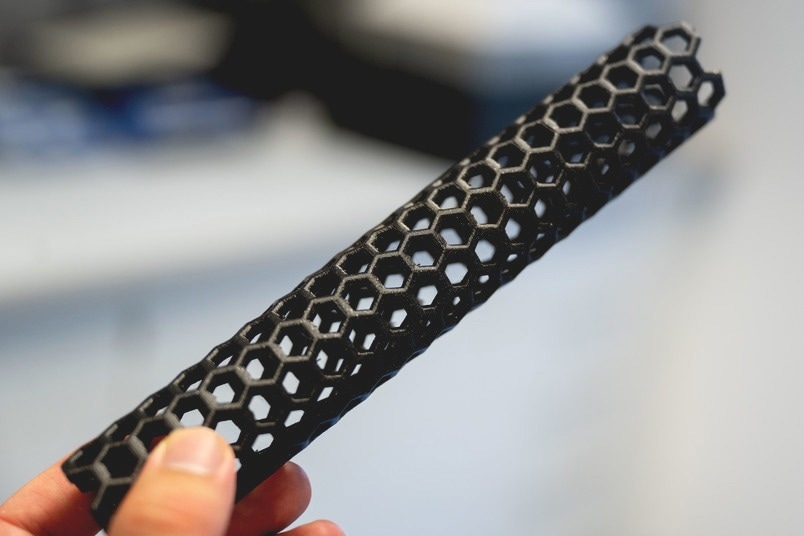Reviewed by Danielle Ellis, B.Sc.Jul 24 2023
An innovative method for building modular optical sensors that can detect viruses and bacteria has been created by an interdisciplinary research team from Bochum, Duisburg, and Zurich. The scientists employed fluorescent carbon nanotubes with new DNA anchors that serve as molecular handles for this purpose.
 3D printed model of a carbon nanotube, the main building block for the new biosensors. Unlike in this 3D printed model, the real nanotubes are 100,000 times thinner than a human hair. Image Credit: RUB, Marquard
3D printed model of a carbon nanotube, the main building block for the new biosensors. Unlike in this 3D printed model, the real nanotubes are 100,000 times thinner than a human hair. Image Credit: RUB, Marquard
The biological recognition parts, such as antibodies and aptamers, can be conjugated to the nanotubes using the anchor structures. The recognition unit can subsequently interact with viral or bacterial substances before reaching the nanotubes. These interactions alter the nanotubes’ fluorescence and change how brilliant they are.
Professor Sebastian Kruss, Justus Metternich, and four other researchers from Ruhr University Bochum (Germany), the ETH Zurich, and the Fraunhofer Institute for Microelectronic Circuits and Systems discussed their findings in the Journal of the American Chemical Society, which was published online on June 27th, 2023.
Straightforward Customization of Carbon Nanotube Biosensors
The group made use of carbon tubular nanosensors with a diameter of less than one nanometer. Carbon nanotubes produce light in the near-infrared region when exposed to visible light. The human eye is not sensitive to near-infrared light. Due to the significantly lower level of other signals in this range, it is ideal for optical applications.
Sebastian Kruss’ team has previously demonstrated how to modulate nanotube fluorescence to find essential biomolecules. Now, the scientists looked for a simple method of adapting the carbon sensors for usage with various target molecules.
The key to success was the use of DNA constructs containing guanine quantum defects. This entailed connecting DNA bases to the nanotube to generate a defect in the nanotube’s crystal structure. As a result, the nanotubes’ fluorescence altered at the quantum level.
Additionally, the defect served as a molecular handle that made it possible to incorporate a detection unit that could be tailored to each target molecule to recognize a particular viral or bacterial protein.
Through the attachment of the detection unit to the DNA anchors, the assembly of such a sensor resembles a system of building blocks—except that the individual parts are 100,000 times smaller than a human hair.”
Sebastian Kruss, Professor, Physical Chemistry, Ruhr University Bochum
Sensor Identifies Different Bacterial and Viral Targets
The SARS CoV-2 spike protein was used as a model by the scientists to demonstrate the new sensor concept. Aptamers, which bind to the SARS CoV-2 spike protein, were utilized by the researchers for this goal.
Aptamers are folded DNA or RNA strands. Due to their structure, they can selectively bind to proteins. In the next step, one could transfer the concept to antibodies or other detection units.”
Justus Metternich, PhD Student, Ruhr University Bochum
With a high degree of dependability, the fluorescent sensors detected the SARS-CoV-2 protein's presence. In comparison to sensors without these defects, sensors containing guanine quantum defects have a greater selectivity. Additionally, the sensors containing guanine quantum defects had higher solution stability.
Kruss added, “This is an advantage if you think about measurements beyond simple aqueous solutions. For diagnostic applications, we have to measure in complex environments e.g., with cells, in the blood or in the organism itself.”
Kruss is also the head of the Functional Interfaces and Biosystems Group at Ruhr University Bochum and a member of the International Graduate School of Neuroscience and the Ruhr Explores Solvation Cluster of Excellence (RESOLV).
Source:
Journal reference:
Metternich, J. T., et al. (2023). Near-Infrared Fluorescent Biosensors Based on Covalent DNA Anchors. Journal of the American Chemical Society. doi.org/10.1021/jacs.3c03336